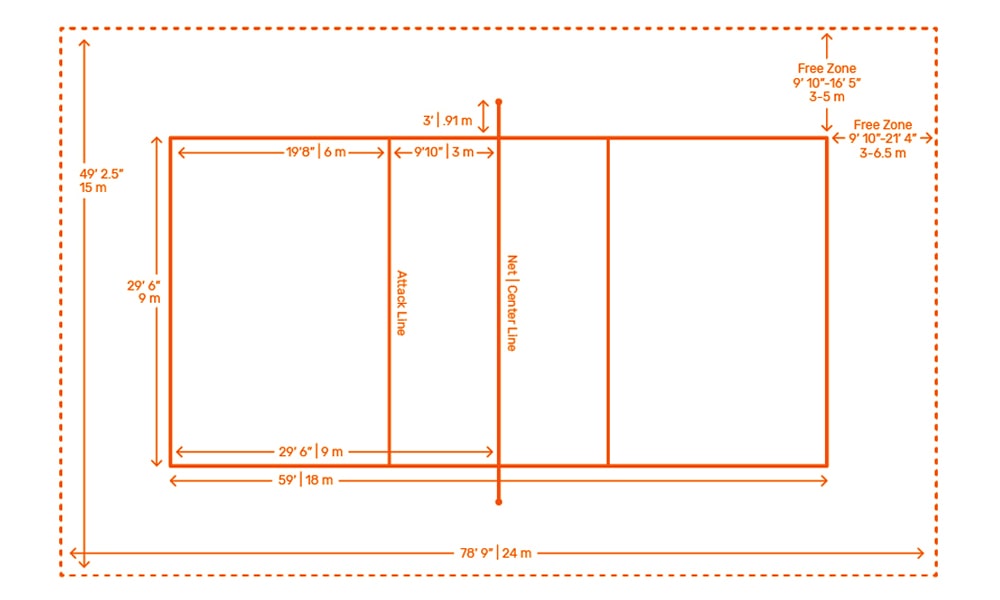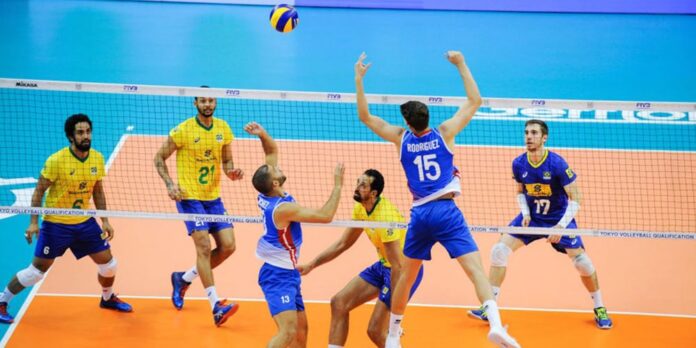Volleyball is a dynamic and exciting sport that combines athleticism, strategy, and teamwork. It Originated in 1895 by William G. Morgan in Holyoke, Massachusetts. Volleyball was initially designed as a less physically demanding alternative to basketball. Over the years, volleyball rules have evolved making it a fast-paced sport. It is a globally popular sport played by millions across various levels. It can be played casually as a beach game or in intense indoor competitions.
The sport’s universal appeal lies in its simplicity and the minimal equipment a ball and a net. Volleyball is played indoors and outdoors. Each format offers unique challenges and thrills. Its adaptability makes it accessible to people of all ages and skill levels. In this article, we will cover the Volleyball rules. It is a comprehensive guide to help players and fans understand the game’s core principles.
Dimensions of the Court
The volleyball court is rectangular. It has various marked lines indicating different zones and boundaries.
- Length of the court is 59 feet (18 meters)
- The width of the court is 29.5 feet (9 meters)
- The net is placed at the center of the court. Having a height of 8 feet (2.43 meters) for men, and 7 feet 4 inches (2.24 meters) for women.
- Attack line separating the frontcourt and backcourt. It is 9 feet 10 inches (3 meters) from the net on each side.
- There is a free zone that extends 9.75ft to 21.33ft from each end of the court.

Markings and Zones
- Center Line: Divides the court into two equal halves.
- Attack Line: Located 9 feet 10 inches from the net, separating the frontcourt and backcourt.
- Service Area: The area behind the end line where the server stands to serve the ball.
- Sidelines and End Lines: Define the boundaries of the court.
Equipment in Volleyball
Volleyball is a sport that requires minimal equipment, making it accessible and easy to set up in various environments. The essential equipment includes a volleyball, a net, and proper court markings. Players must wear appropriate attire.
Volleyball
- The standard volleyball is spherical, with a circumference of 25.5-26.5 inches (65-67 cm), and weighs 9.2-9.9 ounces (260-280 grams).
- Volleyballs are typically made of synthetic leather or leather, with a bladder inside that holds the air.
- The ball must be inflated to the proper pressure, usually between 4.3 and 4.6 psi (pounds per square inch).
Player Attire
- Jersey: Players wear numbered jerseys for identification. The libero wears a different colored jersey to distinguish their role.
- Shoes: Players wear non-marking indoor court shoes with good grip and cushioning.
- Knee Pads: Many players wear knee pads for protection during dives and falls.
- Optional Gear: Some players use ankle supports or braces, arm sleeves, and headbands for additional support and comfort.

Gameplay
Volleyball is a team sport with six players on each side of the court. Each player has a specific role, contributing to both offensive and defensive plays. Every player must adhere to volleyball rules as per their position/role.
Starting the Game: Serve and Rotation
- Each rally begins with a serve from behind the end line.
- A team can win a point by the following:
- Score a point by successfully grounding the ball in the opponent’s court.
- Score a point when the opposing team commits a violation.
- Gain a point directly from a serve that the opponent fails to control or return.
- Teams rotate clockwise each time they win the right to serve.
- Volleyball uses a rally scoring system, where a point is scored on every serve.
- The first team to reach 25 points wins the set, provided they have a two-point lead.
- Matches are usually best-of-five sets. If needed, the fifth set is played to 15 points.
- To win a set, a team must score 25 points with a minimum two-point lead.
- If the match goes to a deciding fifth set, it is played to 15 points with the same two-point lead requirement.
- The team that wins three sets first wins the match.
Serving
There are multiple types of serve for different levels of sports. While serving there are some volleyball rules which must be followed
Types of Serves
- Underhand Serve: Easy to execute; suitable for beginners.
- Overhand Serve: More advanced; it can include topspin and float serves.
- Jump Serve: Adds power and speed, often used by advanced players.
Serving Order
- Teams must serve in the rotational order. Ensuring everyone has the opportunity to serve.
- Teams rotate clockwise each time they win the right to serve.
- If a player serves out of the correct order. It results in a rotational fault, and the opposing team is awarded a point and the serve.
Faults and Penalties
- Serving faults include stepping on or over the end line before contacting the ball.
- Failing to serve the ball over the net or into the opponent’s court.
- Players are not allowed to touch the net during play.
- Touching the net results in a point for the opposing team.
- Teams must maintain their rotational order. Failure to do so results in a point for the opponent.
- A player may not hit the ball twice in succession.
- Lifting or carrying the ball is also a violation, resulting in a point for the opposing team.
- Stepping into the opponent’s court under the net is a violation.
Special Rules
- Teams are allowed a limited number of substitutions per set.
- Substitutes must enter and exit through the substitution zone near the scorer’s table.
- Substitutes usually replace a player in the same rotational position to maintain the sequence.
- Each team is allowed two timeouts per set.
- Timeouts last for 30 seconds and are used to regroup or strategize.
- The libero can replace any back-row player without prior notice to the officials. However, they cannot serve, block, or attempt to block.
Conclusion
Volleyball is a thrilling sport that emphasizes teamwork, strategy, and athleticism. FIVB is the governing body of all kinds of volleyball around the world. Players can improve their performance by understanding the basic Volleyball rules and positions. They can also enjoy the game more. Whether playing casually on the beach or competitively indoors. Volleyball offers a fun and engaging way to stay active and connected.







